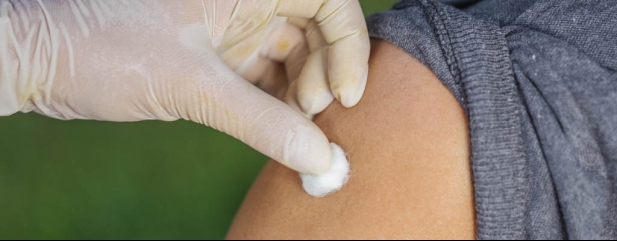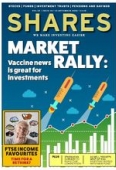Archived article
Please note that tax, investment, pension and ISA rules can change and the information and any views contained in this article may now be inaccurate.
Where we stand after markets’ vaccine boost

The near-5% gain for the FTSE 100 on 9 November reflected news of extremely positive results for the vaccine being developed by Pfizer and BioNTech.
This was the biggest gain since the index surged 9.1% on 24 March when investors reacted to a rescue mission by central banks during the wild trading seen at the outset of the global pandemic. Even this, more modest, November movement ranks among the 10 highest one-day percentage gains for the index.
In the spring there was considerable uncertainty on the path out of the coronavirus crisis and just how damaging it might be. Now the situation on both these variables is a little clearer and that helps explain why market rallied so strongly. Although it is not quite true to say the market has come full circle.
HAS THE FTSE FULLY RECOVERED?
As we write the FTSE 100 is still 15% below its pre-Covid levels – we take 20 February as being when investors really began to price in a material impact from the pandemic.
In contrast, the S&P 500 which, thanks to a combination of the US presidential outcome and the vaccine news, broke new record highs this week.
The gains across the Atlantic were less substantial than those enjoyed by the FTSE 100 and that hints at the changes in stock market leadership we are seeing in the wake of Pfizer’s big announcement.
LOSERS BECOME WINNERS AND VICE VERSA
While Wall Street is dominated by the big technology companies, the UK market has plenty of the old-world economy in its ranks, many of which have seen their valuations smashed on the rocks of the Covid crisis.
These beaten down ‘value’ stocks were suddenly in fashion and we saw some quite spectacular moves, while tech, which sits very much in the ‘growth’ category, and traditional safe havens like government bonds and gold were sold off.
Tech has been one of the few places to find earnings growth in 2020 and so investors have been happy to pay high prices in this area. Many investors now look to be taking the view that some of the worst-performing stocks this year now have a greater chance of earnings recovery, which means they can find growth at a cheaper price and so tech becomes less appealing as valuations start to become more important.
TRAVEL REBOUND
Drilling down to specific sectors, travel was clearly a big winner including British Airways owner International Airlines Group (IAG) which enjoyed intra-day gains of 40%.
Aircraft engine maker Rolls-Royce (RR.) continued the dizzying ascent it has enjoyed since addressing its own financial problems with a recent £2 billion rights issue. Hotels, as well as leisure and hospitality businesses, also soared on hopes they might be able to return to more normal levels of business in the not too distant future.
However, as the graphic shows many stocks remain some way below the levels they were trading at before the pandemic erupted, demonstrating just how far they have fallen in 2020.
OTHER SECTORS RISING
Oil majors BP (BP.) and Royal Dutch Shell (RDSB) were also in demand as oil prices spiked, though again both their share prices and the Brent crude benchmark remain way below pre-Covid levels.
Housebuilders were fired by hopes of an improved economic picture as well as surprisingly punchy guidance from Taylor Wimpey (TW.) that 2021 would be materially ahead of expectations – confidence underpinned by an order book up from £2.7 billion a year earlier to £3 billion. Real estate investment companies, particularly those with exposure to shops and offices, also soared.
LEFT BEHIND IN THE RALLY
Perceived lockdown winners like Just Eat Takeaway (JET) and DIY-firm Kingfisher (KGF) were losers on the day. The biggest faller in the FTSE 100 was online groceries firm Ocado (OCDO) which fell 16.1% to £22.83.
Consumer goods giant Reckitt Benckiser (RB.), which had done well earlier this year after receiving a boost from demand for health and hygiene products, also gave up some of its recent gains.
WHAT HAPPENS NEXT?
Let’s assume the most bullish assumptions are true and there will be a return to some normality by the spring. With very loose monetary policy in play and a possible spending splurge by those consumers which still enjoy a disposable income, there is the possibility of inflation increasing fairly rapidly.
This might see central banks execute a handbrake turn as they look to gain control of rising prices and begin withdrawing stimulus or even increasing ultra-low rates. In this article we talk about the investments which could do well if inflation returns.
Conversely, if there are unexpected delays in the development and distribution of the Pfizer vaccine and others potential vaccines, will investors be patient, or will they look to sell Covid-impaired names once more?
One must also consider the unresolved risks which persist around Brexit and the transfer of power in the US.
Important information:
These articles are provided by Shares magazine which is published by AJ Bell Media, a part of AJ Bell. Shares is not written by AJ Bell.
Shares is provided for your general information and use and is not a personal recommendation to invest. It is not intended to be relied upon by you in making or not making any investment decisions. The investments referred to in these articles will not be suitable for all investors. If in doubt please seek appropriate independent financial advice.
Investors acting on the information in these articles do so at their own risk and AJ Bell Media and its staff do not accept liability for losses suffered by investors as a result of their investment decisions.

 magazine
magazine








